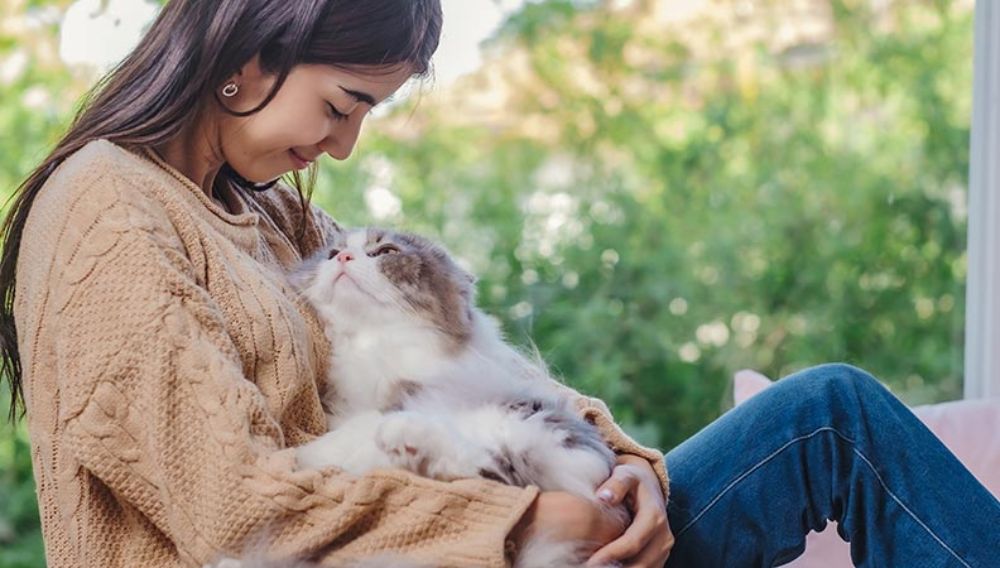
Cat owners often feel their cat is indifferent towards them. But by reading their body language and understanding how cats communicate their feelings and intentions, the signs that your cat loves you will soon become clear! So now it's over to our friends Vetstream to answer the eternal question... Does my cat love me?
How Cats Communicate
Cats communicate to us and other cats using a variety of ways including visual, tactile and vocal signals. They’ll use their eyes, ears, whiskers, mouth, body and tail position to signal how they’re feeling and what they intend to do. They also use chemical signals, including urine marking, and can deposit pheromones from scent glands on their head and face when they facial rub and scratch. Interdigital scent glands between their toes deposit chemical messages when they scratch.
Ways Cats Show Love
Our feline friends' love language is subtle – cats don’t show affection with grand gestures of tail wagging and enthusiastic licks like our doggy companions! A loving cat will just want to hang out with you. They’ll be content to be in the same room as you, snooze on your lap or curl up asleep next to you. Resting or sleeping close to you is a sign they trust you - you’re part of their family and they feel safe, protected and happy in your company.
There are many signs your cat loves you, but how does your cat show love? Here are some of the ways:
- Purring – a relaxed purr indicates contentment. But cats can also purr if they’re stressed or in pain as a way of self-soothing.
- Slow blinking (sometimes known as cat kisses) – if a cat slowly blinks, sometimes with half-closed eyes, this means they trust you and are happy in your company. You can show your cats love by doing the same. Remember though, cats can interpret direct eye contact as threatening.
- Cheek rubs (also known as allorubbing) – this is when your cat rubs their face, body or tail against you and the exchange of chemical signals can take place. It’s a way of marking you with their scent and may be used as a greeting.
- Head butting - another friendly gesture and sign of love. It’s a way of depositing pheromones and letting other cats know you belong to them.
- Showing their belly – this friendly behaviour may be an invitation for tactile contact (a belly rub) in relaxed cat. Note that unfriendly cats can also roll onto their backs when feeling defensive and could lash out with bites and scratches, so be warned!
- Presenting their backside – another show of trust.
- Allogrooming – when a cat grooms their owner. Licking and nibbling (‘love bites’) are signs of affection and indicate you’re part of their family group and there’s a strong bond between you.
- Tail position – a cat will greet their owner with their tail held upright and a slight curve at the top.
- Bringing home ‘gifts’ – if your cat likes to present or reward you with the prey they’ve caught, this may be a sign that your cat loves you. They want to share their hunting success with you (or just enjoy their catch back at base).
- Walking or weaving between your legs or curling their tail around your legs – often used as a ‘welcome home’ signal and that they’ve missed you (but may also be their way of telling you they want something). Tail wrapping is a sign of love.
- Kneading - cats ‘knead’ to stimulate the flow of their mother’s milk. This is instinctive behaviour that some cats continue in adulthood. If your cat likes to repetitively push their front paws into you or another soft surface, it’s likely to be a behaviour that makes them feel good. It may also be a sign of love or a way of marking territory via the scent glands in their paws.
If your cat remains aloof and doesn't show any signs of affection, don’t give up. Some cats just take longer to form a relationship. Their age, personality and past experiences will play a part in how quickly they form a bond with you. Never punish your cat if their body language is negative towards you - be patient, respect their boundaries and they’ll begin to trust you.
So, do cats love their owners? Pay attention to the little clues your cat is giving, and the answer should be easy to see. By gaining their trust and affection and getting to know the ways your feline companion shows love, you and your cat can share a strong and very happy bond together.
Everypaw Cat Insurance
Everypaw's Cat Insurance comes with 24/7 unlimited access to vets and vet nurses that can help with your pet's health, care, nutrition and behaviour. So you can rest assured your pup will be well looked after.
Content provided from Vetstream's Vetlexicon Felis - www.vetlexicon.com/treat/felis
Vetlexicon is the world’s largest peer-reviewed online clinical reference source. All our content is written and peer-reviewed by over 1,000 of the world’s leading veterinarians, ensuring relevance, accuracy and quality.
- Jenna Kiddie & Sarah Ellis (online) Cat communication. In: Vetlexicon Felis. Vetstream Ltd. Website: https://www.vetlexicon.com/felis/behavior/client-factsheets/cat-communication